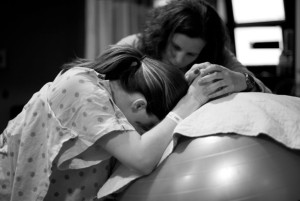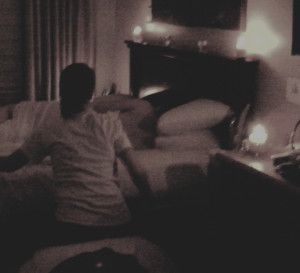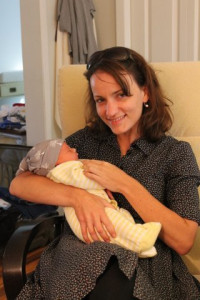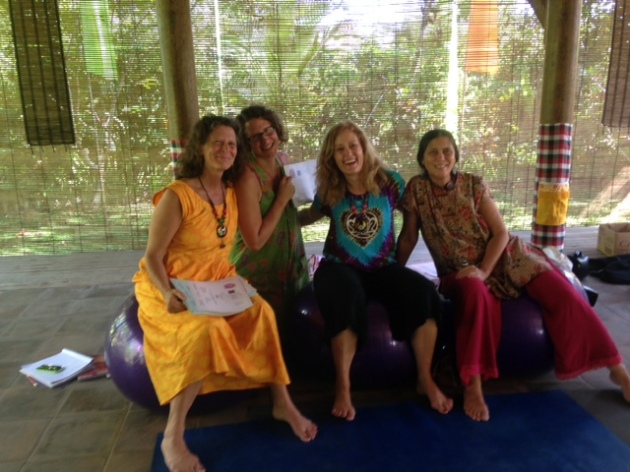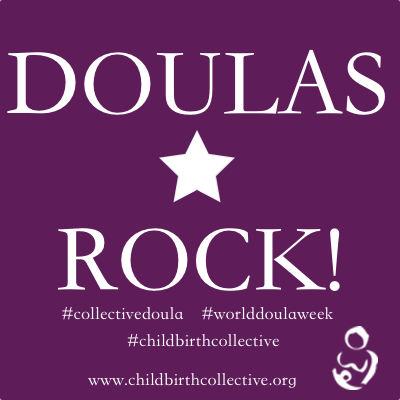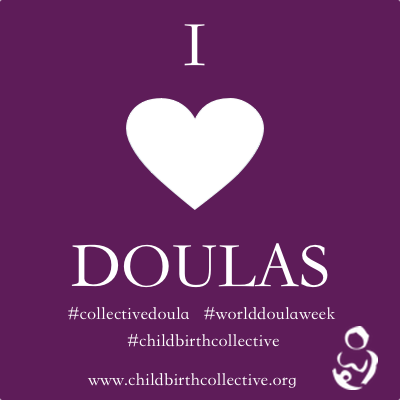by Robyn Hustrulid

Before starting this birth story, I feel the need to mention my 1st and 2nd births. They are the beginning of my journey and very much effected how I gave birth to my 3rd child. My first came a couple weeks early with my water breaking in the middle of the night. I went to the hospital before contractions started and after walking around a bit, they started me on Pitocin. It took the whole day for contractions to get strong, and after 2 hours of strong contractions, an epidural and a cervical check resulting in little progress, the OB recommended a cesarean. Besides asking if we could wait, I didn’t know enough to fight this recommendation, so my first baby came to me via an unplanned, and what I have come to realize, an unnecessary cesarean. The reasoning was “failure to progress,” or maybe we could call it “failure to wait.”
The cesarean wasn’t easy for me to accept. I was happy I had a healthy baby, but not happy with how things went. Breastfeeding started off rocky and recovering from major abdominal surgery was not what I had planned for. I knew I wanted something different for my second birth. I started asking about VBACs (Vaginal Birth After Cesarean) at my 6-week postpartum visit. And then two and a half years later when I got pregnant, I read more books, watched the essential movies, attended some parent topic nights, became a regular at Blooma, switched to a midwife, and hired a doula. I felt prepared and knew that I could accomplish a safe and rewarding VBAC. My labor started at 41 weeks, again with my water breaking in the middle of the night. I stayed home and waited for contractions to get intense, and then went to the hospital. There were a few hiccups of back labor, stalled progress and an epidural, but eventually I welcomed my 2nd baby into the world via a VBAC!

After that experience, I fell in love with the role of the doula, because I knew my first birth would have been different if a doula had been with me. I decided becoming a doula was the right path for me and dove in headfirst. After 2.5 years of witnessing strong mamas welcome their babies into the world, I decided it was time for me to do it again. But again, from all that I had learned and witnessed, I knew this time would be different. I decided to have a homebirth. I hired 2 midwives and 2 doulas. I focused on eating healthy, working out and doing yoga. I also went to the chiropractor regularly to make sure my pelvis was balanced and my body was in alignment. After hearing amazing reviews, I decided to give Hypnobabies a try as well. I was very committed to doing all of the homework and listening to the tracks daily. I was a believer but wasn’t sure if it would work for me until my birthing time came.

On Mother’s Day 2013, my guess date, I decided I wanted to have a low-key day and spend some time with my own mom. I took a nap and listened to the “Come Out Baby” track from Hypnobabies. Then I went for a walk in the afternoon with my mom and a movie after. I had been having Braxton hicks daily for weeks, but started to notice some waves (Hypnobabies term) coming more regularly during the movie. Later I realized this was my early birthing time, but during I dismissed them because they didn’t seem to be getting stronger. These waves continued on through the night as I ate dinner with my kids, did the dishes (while listening to Birthing Day Affirmations) and then put the kids to bed. I went to bed thinking nothing was happening, but decided to listen to my “Deepening” track. I wasn’t able to fall asleep because the waves were getting a bit stronger. Around 11:30, I felt some fluid leak a couple times and thought I was peeing, so I decided I should go to the bathroom. When I stood up, I felt a gush between my legs and knew exactly what was happening. I sat on the toilet and felt a bit stunned, excited, anxious, and in disbelief. I called to my husband that “my water broke.” It took him a bit to wake up, but then he got up, and we started getting things together.

I made my phone calls; told my mom to come over to sleep, and I let the midwives and doulas know that it was happening, but I didn’t need them yet. I could feel the waves but they weren’t very strong, so we decided to get everything ready and then go back to bed. David set up the birth tub and got me some water. I got the camera, some snacks, the Hypnobabies scripts and my iPod out. My mom got to our house around 12:30. I told her “this one is sure different.” I had a few waves in the kitchen and leaned over the counter while breathing through them. They still felt somewhat mild to me or just like pressure. I was sure there was a lot of time left.
Around 1am, after we felt like things were gathered and set up, I asked David to do the rebozo for a bit. I was feeling some of the waves in my back so we wanted to encourage baby to get in a good position. After a couple waves, I got up and sat on the ball and David turned on the “Fear Clearing” track. The waves started to get a little more intense, so I decided to call my midwife around 1:30am. She asked how close they were, and we had no idea. So she asked that we time a few and call her back. After timing them and seeing that they were 3 minutes apart, I realized that things were moving faster than I thought, but I still felt like it was early in my birthing time. My midwife decided they should come, so I also called my doulas to come. My midwife also suggested we do an initial fill of the birth tub, because it would probably take a couple, and we would need time for the water heater to heat more water.

With every wave, I was leaking a lot of fluid, so I decided to get in the shower. I let the hot water run on my breasts in between the waves and drew peace signs and hearts on the steamed up shower door. During the waves, I leaned over and let the hot water run on my back. My mom got me my water bottle, and I put it in the shower with me. I could hear some of the Hypnobabies in the background, and I was saying, “Open, Open, Open.” After the waves I would burp, and I smiled as I remembered my midwife telling me that was a sign of active labor. I loved the shower and the routine/rhythm I had created. But sadly, because we were also filling the tub, the hot water ran out. I got out and sat on the toilet around 2:25am. My mom started to boil some water just in case. I didn’t realize it at the time, but my mom and David started to get a little anxious for the midwives to get there. My mom asked David if he could deliver the baby if need be. He just grinned and put his hands out like he was catching a baby.

One of my doulas arrived around 2:30. She took note that waves were about 2 minutes apart, and I was listening to Birthing Affirmations. I remember using my peace cue during waves, and feeling like it was really helping. My doula said relax, and I could feel my shoulders melt and my body soften. Around 2:45 one of my midwives arrived, so my mom was able to relax. My doula suggested I eat something, so David went and got me some yogurt and an Emergen-C drink. The midwife in training arrived shortly after, and then my other doula. One of my doulas came and put her hands on my shoulders and forehead and told me to relax.

My midwife tried to hear the baby with a fetoscope but wasn’t able to get a good angle while I was on the toilet. My other midwife arrived and also tried to listen to baby while I was on the toilet, but it wasn’t working, so they asked me to stand up. I stood up and leaned over my sink. My doula did some double hip squeezes and massaged my back, which felt wonderful. My midwife was still unable to find the baby with the fetoscope, so she asked if I wanted to get in the bed or use the Doppler. I couldn’t imagine lying down, so I said Doppler. She found my baby’s heartbeat, and it was perfect. I remember hearing on the Hypnobabies track, “say your baby’s name.” And I said, “I don’t know your name.”
At 3:24 I asked if I could get in the tub. It wasn’t ready yet, so one of my doulas went downstairs and helped my mom bring the boiling water up to fill the tub. David and my other doula were checking to see if the water was warm enough to start filling it with the hose. Around 3:30, I started to feel like I needed to poop; my doula mind knew what that meant, but I wasn’t ready to admit it out loud yet. As the pressure built, I asked again if I could get in the tub, but it still wasn’t ready. One of my doulas suggested I sit on the toilet while I waited. When my first wave came while on the toilet, I felt my whole body start to push and I couldn’t resist it. I had about two waves like that, and heard my midwife say, “she is going to have that baby on the toilet.” I said, “I NEED to get in the tub.”

Around 3:40 I got in the tub, and my mom was still dumping hot water in it. When the first wave started to build, I got into a froggy squat position. It felt like the rise of a roller coaster, excitement, nervous, anxious and joy in the anticipation. I knew once I got to the top there wasn’t anything I could do. This baby was coming down, and I was just along for the ride. I felt my whole body start to involuntarily push. It was such an unusual feeling, and I knew I had no control and needed to surrender. The “Pushing” track was on, and I remember sending peace down and out in front of my baby’s head. After the wave, I leaned over the side of the tub, rested my head on the edge and asked for cold washcloths. David held one on my forehead and someone put one on my neck. While pushing I could feel the baby’s head moving down and then rocking back up in between waves. My midwives told me I could reach down and feel the head during the next wave, and it was then that I finally believed I would meet my baby soon.

Just before 4am, one of my doulas asked if I was ready for the kids to come in. I said I didn’t know and asked if they thought the kids could handle it. Everyone said yes, so I said ok. My mom woke up Kyle and Jolie and they came around the corner sleepy eyed and smiling. They got pillows and blankets and lied in the hallway. They would sit up and watch as they heard me making grunting and pushing sounds. Kyle asked my mom, “What’s all the drama?” Apparently I was making more noise than the women in the movies I had showed them. In between waves, I asked Kyle if he was ok and he said yes and didn’t look the slightest bit scared.

My midwife suggested I tilt my pelvis during the next wave so the baby could get past my pubic bone. What a difference that made, I could feel the baby move down even further and stay down. During the next wave I sat back and thought in my head I’m going to keep pushing even if I feel burning. I reached down to feel the head coming out, and then the wave stopped. I asked, “is this ok,” even though I knew it was. My midwife assured me it was just fine and the baby’s color looked great. During the next wave, I could feel the shoulder come out and then the rest of the body slide out. I brought my baby up on my chest and felt the most incredible rush of emotions. “Oh my God, oh my God, oh my God, this was awesome! Everybody should do it!” And then I heard my son say, “it’s a boy!” My sweet little man, Bryce David Hustrulid, came into this world in such a beautiful way at 4:04am and changed our lives forever!

Bryce David Hustrulid born May 13, 2013 at 4:04am
8lbs 14oz, 21 inches




